Zinc Oxide Quantum Dots: Applications and Properties
VerifiedAdded on 2020/03/16
|9
|2436
|135
AI Summary
This assignment delves into the characteristics, synthesis methods, mechanical properties, history, and various applications of zinc oxide quantum dots. It highlights their suitability for fields like bioimaging, gene therapy, drug delivery, and cancer therapy due to their unique chemical, physical, and mechanical attributes such as high ultraviolet light absorption, optical transparency, and tensile strength. The document emphasizes the importance of understanding these properties for effective utilization in diverse nanotechnology applications.
Contribute Materials
Your contribution can guide someone’s learning journey. Share your
documents today.
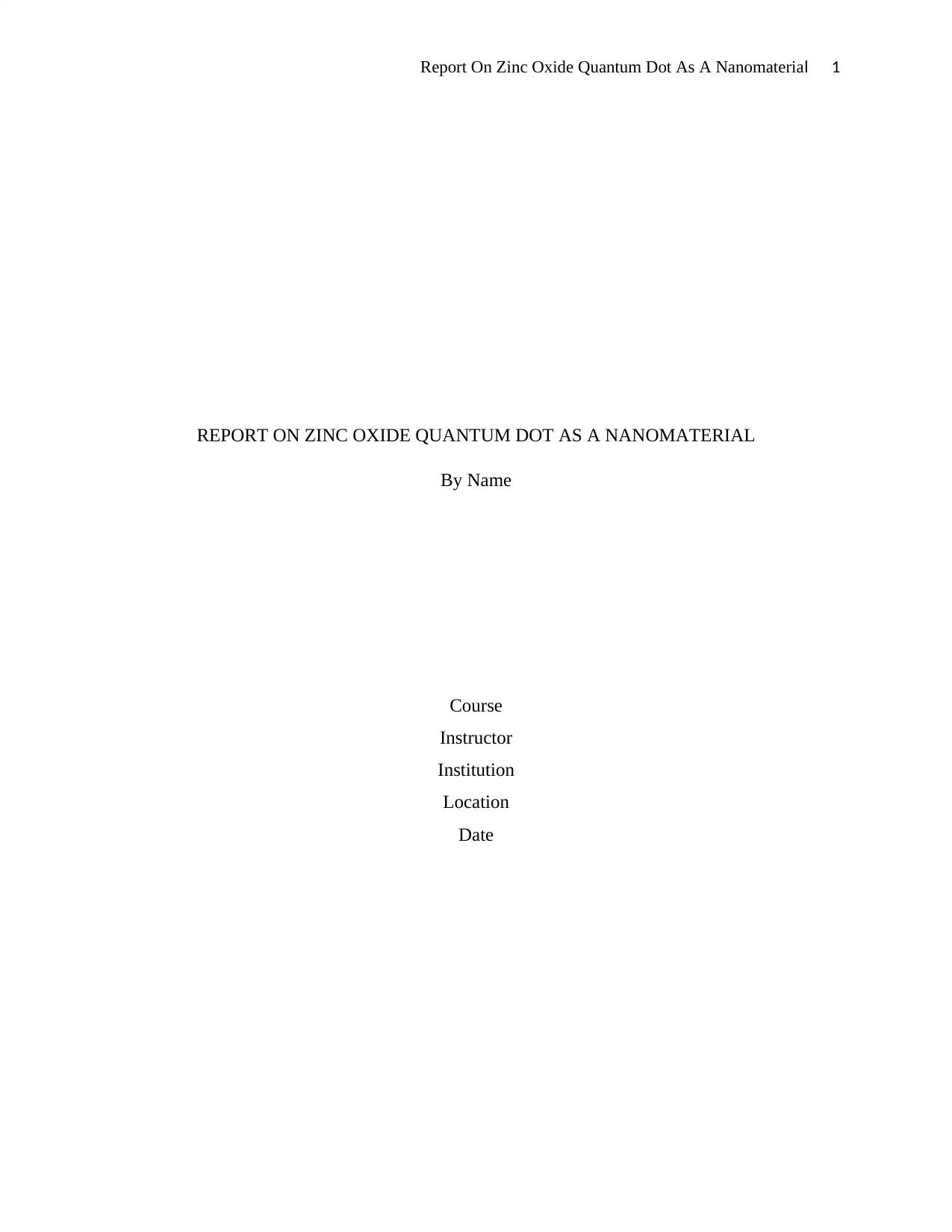
Report On Zinc Oxide Quantum Dot As A Nanomaterial 1
REPORT ON ZINC OXIDE QUANTUM DOT AS A NANOMATERIAL
By Name
Course
Instructor
Institution
Location
Date
REPORT ON ZINC OXIDE QUANTUM DOT AS A NANOMATERIAL
By Name
Course
Instructor
Institution
Location
Date
Secure Best Marks with AI Grader
Need help grading? Try our AI Grader for instant feedback on your assignments.

Report On Zinc Oxide Quantum Dot As A Nanomaterial 2
Introduction
Various fields of science and engineering have adopted the utilization of nanotechnology. This
generally deals with the scaling down of materials to a Nanoscale. This implies that the size of
the material must be greatly reduced, and this influences the mechanical, chemical and physical
properties of the materials. This research paper will generally focus on the zinc oxide
nanoparticle. Its history and the role that it technological plays in the technology industry have
also been underlined (Bishop, 2013).
History of zinc oxide quantum dots
Zinc Oxide Quantum Dots encompass of zinc oxide particles which are covered with -COOH
and –OH groups. They are hydrophilic Nanocrystals that have an emission wavelength estimated
at 550nm. These dots does not comprise any pollutant -.their elements are accessible in large
volumes, for instance, Cobalt and Lanthanum-doped ZnO (Chopra, 2012).
Besides, the zinc oxide quantum dots are categorized by their nature of X-ray powder diffraction,
energy dispersive X-ray analysis and the high-resolution transmission electron microscopy. They
possess desirable optical properties and have a reduced size and an improved fluorescence more
so for the Cobalt and Lanthanum-doped ZnO. These doped elements exhibit an electromagnetic
behavior at room temperature. In addition, these quantum dots have the possibility of making the
BGC 803 cells effectively within a very short duration with no elements of toxicity or adversarial
effects on the growth of cell even at high concentrations. The zinc oxide nanoparticles have a
very wide application in the fields of nanotechnology i.e. bioimaging, gene therapy, drug
delivery and cancer therapy (Ebbesen, 2010).
Structure and synthesis of zinc oxide quantum dots
There exists different structure of zinc oxide nanoparticles and they are synthesized using
different techniques. These techniques can either group as either physical, biological or chemical
synthesis .however the structures can be grouped depending on the dimension of the
nanoparticles. They can either be a one-dimensional nanoparticle, two-dimensional nanoparticle
or even three-dimensional nanoparticle. Below are some of the pictures of the structures of the
nanoparticles.
Introduction
Various fields of science and engineering have adopted the utilization of nanotechnology. This
generally deals with the scaling down of materials to a Nanoscale. This implies that the size of
the material must be greatly reduced, and this influences the mechanical, chemical and physical
properties of the materials. This research paper will generally focus on the zinc oxide
nanoparticle. Its history and the role that it technological plays in the technology industry have
also been underlined (Bishop, 2013).
History of zinc oxide quantum dots
Zinc Oxide Quantum Dots encompass of zinc oxide particles which are covered with -COOH
and –OH groups. They are hydrophilic Nanocrystals that have an emission wavelength estimated
at 550nm. These dots does not comprise any pollutant -.their elements are accessible in large
volumes, for instance, Cobalt and Lanthanum-doped ZnO (Chopra, 2012).
Besides, the zinc oxide quantum dots are categorized by their nature of X-ray powder diffraction,
energy dispersive X-ray analysis and the high-resolution transmission electron microscopy. They
possess desirable optical properties and have a reduced size and an improved fluorescence more
so for the Cobalt and Lanthanum-doped ZnO. These doped elements exhibit an electromagnetic
behavior at room temperature. In addition, these quantum dots have the possibility of making the
BGC 803 cells effectively within a very short duration with no elements of toxicity or adversarial
effects on the growth of cell even at high concentrations. The zinc oxide nanoparticles have a
very wide application in the fields of nanotechnology i.e. bioimaging, gene therapy, drug
delivery and cancer therapy (Ebbesen, 2010).
Structure and synthesis of zinc oxide quantum dots
There exists different structure of zinc oxide nanoparticles and they are synthesized using
different techniques. These techniques can either group as either physical, biological or chemical
synthesis .however the structures can be grouped depending on the dimension of the
nanoparticles. They can either be a one-dimensional nanoparticle, two-dimensional nanoparticle
or even three-dimensional nanoparticle. Below are some of the pictures of the structures of the
nanoparticles.

Report On Zinc Oxide Quantum Dot As A Nanomaterial 3
(Diagram of zinc oxide nanomaterial; a-f represents one dimensional nanoparticles, g-j
represents two dimensional nanoparticles, the rest represents three dimensional nanoparticles)
(Ebbesen, 2010).
Chemical synthesis
These type of synthesis is chemically achieved and can further be divided into either liquid or
gas synthesis (Etching, 2008).
Liquid phase synthesis
These include methods such as synthesis, colloidal aspects, hydrothermal synthesis, and co-
synthesis among others. In this technique, a liquid agent is always allowed to react with the zinc
oxide nanoparticles. Thereafter the resulting particle which is either soluble or insoluble is
washed and heated at different temperatures to come up with the differently desired
nanoparticles.
Gas phase synthesis
Also known as vacuum synthesis techniques is either achieved through gas condensation method
or through pyrolysis. Pyrolysis is whereby the flame heating is used to generate aerosol droplets
from the zinc salt and then dispersed into gas thereby reducing their size. After which it is
exposed to condensation and sintering (Franssila, 2010).
(Diagram of zinc oxide nanomaterial; a-f represents one dimensional nanoparticles, g-j
represents two dimensional nanoparticles, the rest represents three dimensional nanoparticles)
(Ebbesen, 2010).
Chemical synthesis
These type of synthesis is chemically achieved and can further be divided into either liquid or
gas synthesis (Etching, 2008).
Liquid phase synthesis
These include methods such as synthesis, colloidal aspects, hydrothermal synthesis, and co-
synthesis among others. In this technique, a liquid agent is always allowed to react with the zinc
oxide nanoparticles. Thereafter the resulting particle which is either soluble or insoluble is
washed and heated at different temperatures to come up with the differently desired
nanoparticles.
Gas phase synthesis
Also known as vacuum synthesis techniques is either achieved through gas condensation method
or through pyrolysis. Pyrolysis is whereby the flame heating is used to generate aerosol droplets
from the zinc salt and then dispersed into gas thereby reducing their size. After which it is
exposed to condensation and sintering (Franssila, 2010).

Report On Zinc Oxide Quantum Dot As A Nanomaterial 4
The gas condensation techniques are achieved either physically or chemically but the main
principle that they use is the condensation of a zinc source within a chamber by use of a resistive
heat.
Physical phase synthesis
There are also different techniques entailed in this aspect including physical vapour deposition,
squatter deposition, ion implantation, ball milling among other methods. The production rates of
the zinc nanoparticles are always increased thereby appropriate for industrial applications. The
ball milling process has been proved to be simple and effective and efficient since they only
involve the placing of a powdered material inside a ball mill and then passing balls containing
the high energy of collisions (Liu, 2013).
Biological synthesis phase
Also known as the green synthesis of the nanoparticles, produces the least amount of pollutants.
This technique is cheap and efficient enough and uses a variety of microorganisms during the
synthesis i.e. Fungi, virus and algae are used in the synthesis process. The methods used in the
biological synthesis includes
Plant-mediated synthesis – this method involve the use of plant extracts to either act as reducing
or capping agents. This technique is very simple and applies the vivo and vitro mechanisms, but
they are only limited to some materials (Fan, 2014).
Microorganism mediated synthesis – usually in this techniques, the eco-friendly microbes are
used and they can either be extracellular or intracellular synthesis. It is one of the
recommendation techniques due to its non-pollutant nature and thus is widely applied in the
fields of bioleaching, Biomineralization and also bioremediation. The intracellular synthesis will
involve the incubation of fungal biomass in darkness with a solution of zinc salt for a particular
time period while the extracellular synthesis involves treatment of the fungal filtrates with a
precursor solution.
Other mediated techniques include distillation method by use of methanol proceeded by boiling
thereby producing aggregates of the nanoparticles (Tilli, 2009).
Characterization
The gas condensation techniques are achieved either physically or chemically but the main
principle that they use is the condensation of a zinc source within a chamber by use of a resistive
heat.
Physical phase synthesis
There are also different techniques entailed in this aspect including physical vapour deposition,
squatter deposition, ion implantation, ball milling among other methods. The production rates of
the zinc nanoparticles are always increased thereby appropriate for industrial applications. The
ball milling process has been proved to be simple and effective and efficient since they only
involve the placing of a powdered material inside a ball mill and then passing balls containing
the high energy of collisions (Liu, 2013).
Biological synthesis phase
Also known as the green synthesis of the nanoparticles, produces the least amount of pollutants.
This technique is cheap and efficient enough and uses a variety of microorganisms during the
synthesis i.e. Fungi, virus and algae are used in the synthesis process. The methods used in the
biological synthesis includes
Plant-mediated synthesis – this method involve the use of plant extracts to either act as reducing
or capping agents. This technique is very simple and applies the vivo and vitro mechanisms, but
they are only limited to some materials (Fan, 2014).
Microorganism mediated synthesis – usually in this techniques, the eco-friendly microbes are
used and they can either be extracellular or intracellular synthesis. It is one of the
recommendation techniques due to its non-pollutant nature and thus is widely applied in the
fields of bioleaching, Biomineralization and also bioremediation. The intracellular synthesis will
involve the incubation of fungal biomass in darkness with a solution of zinc salt for a particular
time period while the extracellular synthesis involves treatment of the fungal filtrates with a
precursor solution.
Other mediated techniques include distillation method by use of methanol proceeded by boiling
thereby producing aggregates of the nanoparticles (Tilli, 2009).
Characterization
Secure Best Marks with AI Grader
Need help grading? Try our AI Grader for instant feedback on your assignments.
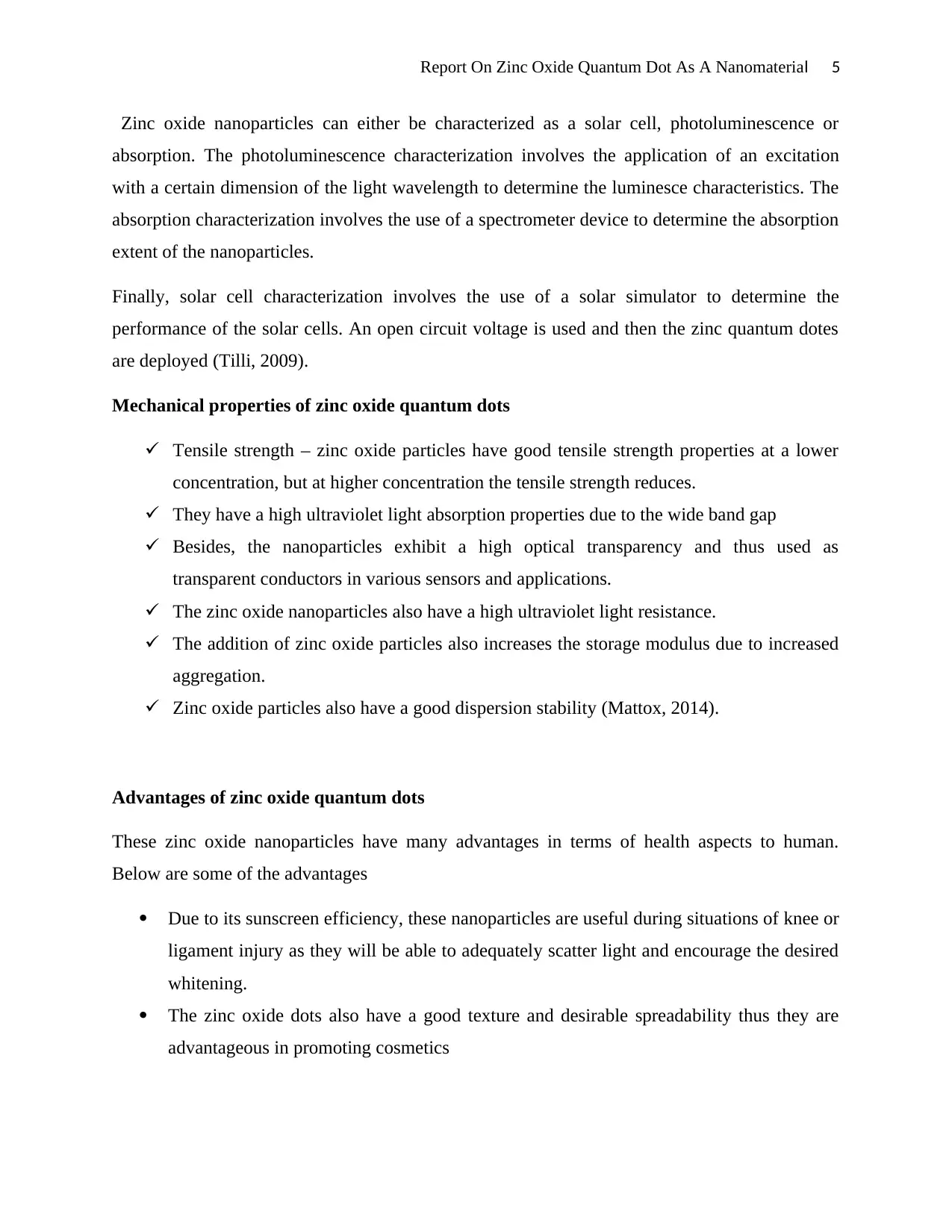
Report On Zinc Oxide Quantum Dot As A Nanomaterial 5
Zinc oxide nanoparticles can either be characterized as a solar cell, photoluminescence or
absorption. The photoluminescence characterization involves the application of an excitation
with a certain dimension of the light wavelength to determine the luminesce characteristics. The
absorption characterization involves the use of a spectrometer device to determine the absorption
extent of the nanoparticles.
Finally, solar cell characterization involves the use of a solar simulator to determine the
performance of the solar cells. An open circuit voltage is used and then the zinc quantum dotes
are deployed (Tilli, 2009).
Mechanical properties of zinc oxide quantum dots
Tensile strength – zinc oxide particles have good tensile strength properties at a lower
concentration, but at higher concentration the tensile strength reduces.
They have a high ultraviolet light absorption properties due to the wide band gap
Besides, the nanoparticles exhibit a high optical transparency and thus used as
transparent conductors in various sensors and applications.
The zinc oxide nanoparticles also have a high ultraviolet light resistance.
The addition of zinc oxide particles also increases the storage modulus due to increased
aggregation.
Zinc oxide particles also have a good dispersion stability (Mattox, 2014).
Advantages of zinc oxide quantum dots
These zinc oxide nanoparticles have many advantages in terms of health aspects to human.
Below are some of the advantages
Due to its sunscreen efficiency, these nanoparticles are useful during situations of knee or
ligament injury as they will be able to adequately scatter light and encourage the desired
whitening.
The zinc oxide dots also have a good texture and desirable spreadability thus they are
advantageous in promoting cosmetics
Zinc oxide nanoparticles can either be characterized as a solar cell, photoluminescence or
absorption. The photoluminescence characterization involves the application of an excitation
with a certain dimension of the light wavelength to determine the luminesce characteristics. The
absorption characterization involves the use of a spectrometer device to determine the absorption
extent of the nanoparticles.
Finally, solar cell characterization involves the use of a solar simulator to determine the
performance of the solar cells. An open circuit voltage is used and then the zinc quantum dotes
are deployed (Tilli, 2009).
Mechanical properties of zinc oxide quantum dots
Tensile strength – zinc oxide particles have good tensile strength properties at a lower
concentration, but at higher concentration the tensile strength reduces.
They have a high ultraviolet light absorption properties due to the wide band gap
Besides, the nanoparticles exhibit a high optical transparency and thus used as
transparent conductors in various sensors and applications.
The zinc oxide nanoparticles also have a high ultraviolet light resistance.
The addition of zinc oxide particles also increases the storage modulus due to increased
aggregation.
Zinc oxide particles also have a good dispersion stability (Mattox, 2014).
Advantages of zinc oxide quantum dots
These zinc oxide nanoparticles have many advantages in terms of health aspects to human.
Below are some of the advantages
Due to its sunscreen efficiency, these nanoparticles are useful during situations of knee or
ligament injury as they will be able to adequately scatter light and encourage the desired
whitening.
The zinc oxide dots also have a good texture and desirable spreadability thus they are
advantageous in promoting cosmetics
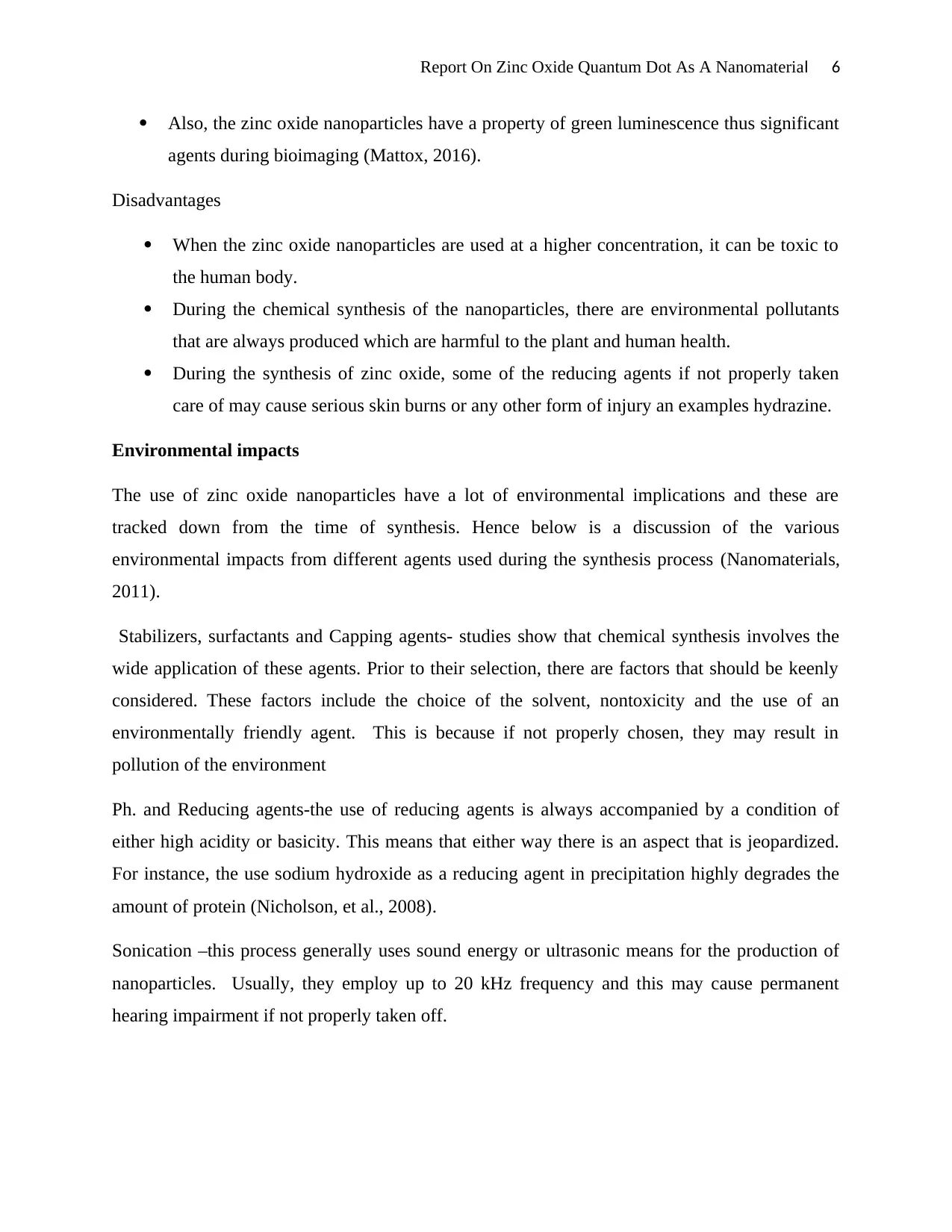
Report On Zinc Oxide Quantum Dot As A Nanomaterial 6
Also, the zinc oxide nanoparticles have a property of green luminescence thus significant
agents during bioimaging (Mattox, 2016).
Disadvantages
When the zinc oxide nanoparticles are used at a higher concentration, it can be toxic to
the human body.
During the chemical synthesis of the nanoparticles, there are environmental pollutants
that are always produced which are harmful to the plant and human health.
During the synthesis of zinc oxide, some of the reducing agents if not properly taken
care of may cause serious skin burns or any other form of injury an examples hydrazine.
Environmental impacts
The use of zinc oxide nanoparticles have a lot of environmental implications and these are
tracked down from the time of synthesis. Hence below is a discussion of the various
environmental impacts from different agents used during the synthesis process (Nanomaterials,
2011).
Stabilizers, surfactants and Capping agents- studies show that chemical synthesis involves the
wide application of these agents. Prior to their selection, there are factors that should be keenly
considered. These factors include the choice of the solvent, nontoxicity and the use of an
environmentally friendly agent. This is because if not properly chosen, they may result in
pollution of the environment
Ph. and Reducing agents-the use of reducing agents is always accompanied by a condition of
either high acidity or basicity. This means that either way there is an aspect that is jeopardized.
For instance, the use sodium hydroxide as a reducing agent in precipitation highly degrades the
amount of protein (Nicholson, et al., 2008).
Sonication –this process generally uses sound energy or ultrasonic means for the production of
nanoparticles. Usually, they employ up to 20 kHz frequency and this may cause permanent
hearing impairment if not properly taken off.
Also, the zinc oxide nanoparticles have a property of green luminescence thus significant
agents during bioimaging (Mattox, 2016).
Disadvantages
When the zinc oxide nanoparticles are used at a higher concentration, it can be toxic to
the human body.
During the chemical synthesis of the nanoparticles, there are environmental pollutants
that are always produced which are harmful to the plant and human health.
During the synthesis of zinc oxide, some of the reducing agents if not properly taken
care of may cause serious skin burns or any other form of injury an examples hydrazine.
Environmental impacts
The use of zinc oxide nanoparticles have a lot of environmental implications and these are
tracked down from the time of synthesis. Hence below is a discussion of the various
environmental impacts from different agents used during the synthesis process (Nanomaterials,
2011).
Stabilizers, surfactants and Capping agents- studies show that chemical synthesis involves the
wide application of these agents. Prior to their selection, there are factors that should be keenly
considered. These factors include the choice of the solvent, nontoxicity and the use of an
environmentally friendly agent. This is because if not properly chosen, they may result in
pollution of the environment
Ph. and Reducing agents-the use of reducing agents is always accompanied by a condition of
either high acidity or basicity. This means that either way there is an aspect that is jeopardized.
For instance, the use sodium hydroxide as a reducing agent in precipitation highly degrades the
amount of protein (Nicholson, et al., 2008).
Sonication –this process generally uses sound energy or ultrasonic means for the production of
nanoparticles. Usually, they employ up to 20 kHz frequency and this may cause permanent
hearing impairment if not properly taken off.
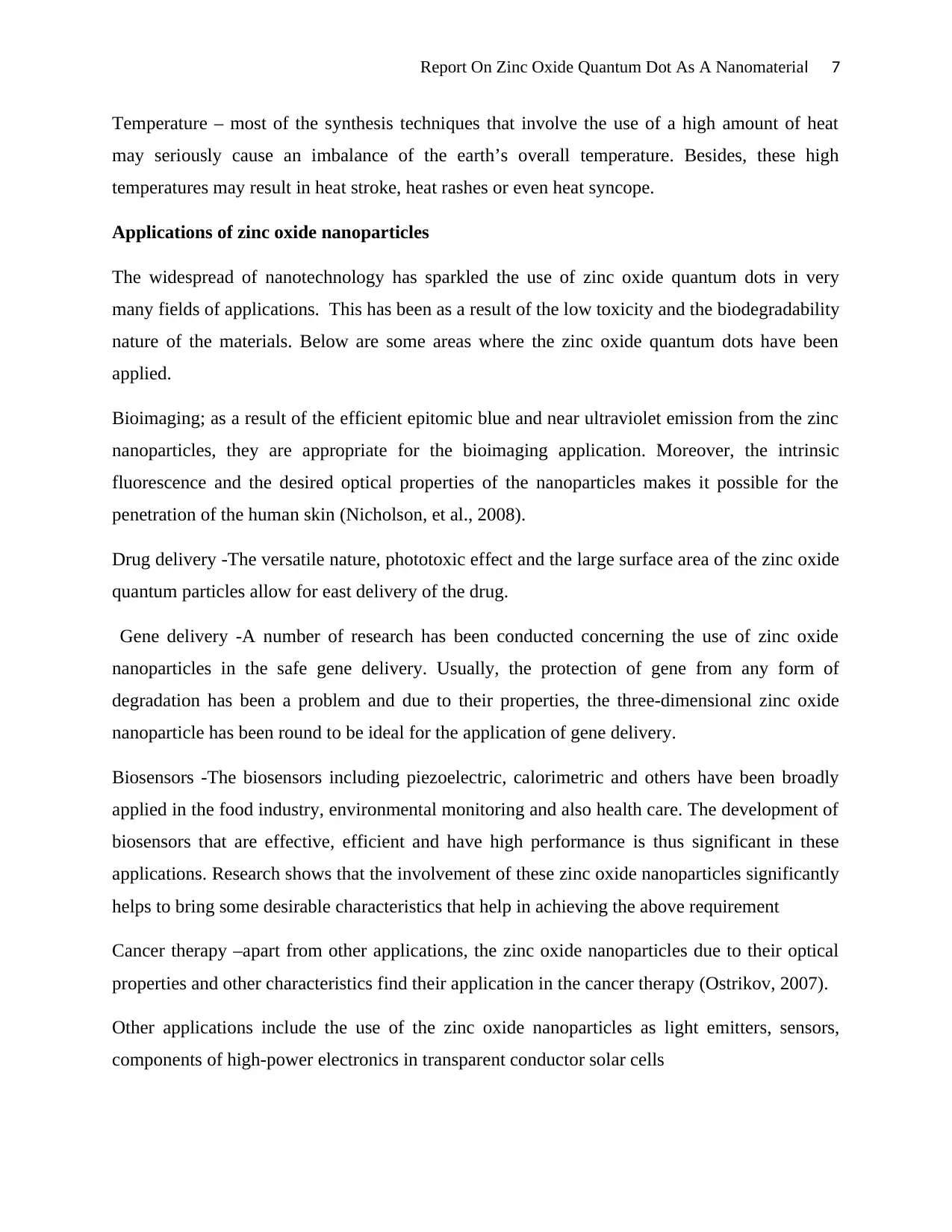
Report On Zinc Oxide Quantum Dot As A Nanomaterial 7
Temperature – most of the synthesis techniques that involve the use of a high amount of heat
may seriously cause an imbalance of the earth’s overall temperature. Besides, these high
temperatures may result in heat stroke, heat rashes or even heat syncope.
Applications of zinc oxide nanoparticles
The widespread of nanotechnology has sparkled the use of zinc oxide quantum dots in very
many fields of applications. This has been as a result of the low toxicity and the biodegradability
nature of the materials. Below are some areas where the zinc oxide quantum dots have been
applied.
Bioimaging; as a result of the efficient epitomic blue and near ultraviolet emission from the zinc
nanoparticles, they are appropriate for the bioimaging application. Moreover, the intrinsic
fluorescence and the desired optical properties of the nanoparticles makes it possible for the
penetration of the human skin (Nicholson, et al., 2008).
Drug delivery -The versatile nature, phototoxic effect and the large surface area of the zinc oxide
quantum particles allow for east delivery of the drug.
Gene delivery -A number of research has been conducted concerning the use of zinc oxide
nanoparticles in the safe gene delivery. Usually, the protection of gene from any form of
degradation has been a problem and due to their properties, the three-dimensional zinc oxide
nanoparticle has been round to be ideal for the application of gene delivery.
Biosensors -The biosensors including piezoelectric, calorimetric and others have been broadly
applied in the food industry, environmental monitoring and also health care. The development of
biosensors that are effective, efficient and have high performance is thus significant in these
applications. Research shows that the involvement of these zinc oxide nanoparticles significantly
helps to bring some desirable characteristics that help in achieving the above requirement
Cancer therapy –apart from other applications, the zinc oxide nanoparticles due to their optical
properties and other characteristics find their application in the cancer therapy (Ostrikov, 2007).
Other applications include the use of the zinc oxide nanoparticles as light emitters, sensors,
components of high-power electronics in transparent conductor solar cells
Temperature – most of the synthesis techniques that involve the use of a high amount of heat
may seriously cause an imbalance of the earth’s overall temperature. Besides, these high
temperatures may result in heat stroke, heat rashes or even heat syncope.
Applications of zinc oxide nanoparticles
The widespread of nanotechnology has sparkled the use of zinc oxide quantum dots in very
many fields of applications. This has been as a result of the low toxicity and the biodegradability
nature of the materials. Below are some areas where the zinc oxide quantum dots have been
applied.
Bioimaging; as a result of the efficient epitomic blue and near ultraviolet emission from the zinc
nanoparticles, they are appropriate for the bioimaging application. Moreover, the intrinsic
fluorescence and the desired optical properties of the nanoparticles makes it possible for the
penetration of the human skin (Nicholson, et al., 2008).
Drug delivery -The versatile nature, phototoxic effect and the large surface area of the zinc oxide
quantum particles allow for east delivery of the drug.
Gene delivery -A number of research has been conducted concerning the use of zinc oxide
nanoparticles in the safe gene delivery. Usually, the protection of gene from any form of
degradation has been a problem and due to their properties, the three-dimensional zinc oxide
nanoparticle has been round to be ideal for the application of gene delivery.
Biosensors -The biosensors including piezoelectric, calorimetric and others have been broadly
applied in the food industry, environmental monitoring and also health care. The development of
biosensors that are effective, efficient and have high performance is thus significant in these
applications. Research shows that the involvement of these zinc oxide nanoparticles significantly
helps to bring some desirable characteristics that help in achieving the above requirement
Cancer therapy –apart from other applications, the zinc oxide nanoparticles due to their optical
properties and other characteristics find their application in the cancer therapy (Ostrikov, 2007).
Other applications include the use of the zinc oxide nanoparticles as light emitters, sensors,
components of high-power electronics in transparent conductor solar cells
Paraphrase This Document
Need a fresh take? Get an instant paraphrase of this document with our AI Paraphraser

Report On Zinc Oxide Quantum Dot As A Nanomaterial 8
The composites of ZnO and PMMA can be potentially applied in protective layers, UV
protecting films, as flame retardant materials transparent barrier, and as and consequently,
antireflection coatings
Conclusion
The research report was to describe one of the nanomaterial in terms of some aspects such as the
characterization, synthesis techniques, mechanical properties, history and then the various fields
of applications and its advantages and the limitations. Zinc oxide quantum dots was chosen as
the topic of research and the various applications have been described above. There are very
many areas in the nanotechnology sector where the zinc oxide particles are used. For instance
bioimaging, gene therapy, drug delivery and cancer therapy. These applications are directly
linked to the chemical, physical and mechanical properties of the zinc oxide quantum dots. As
seen above zinc oxide poses desirable mechanical properties such as good tensile strength
properties at a lower concentration, high ultraviolet light absorption properties, high optical
transparency, and high ultraviolet light resistance. Increased modulus and good dispersion
stability. These properties make it suitable for the applications in respective fields
(Nanomaterials, 2011).
References
Bishop, C., 2013. Vacuum Deposition onto Webs, Films, and Foils. Wilmington: Elsevier
Science.
Chopra, K., 2012. Thin Film Device Applications. illustrated ed. Nawanshahr: Springer Science
& Business Media.
Ebbesen, W., 2010. Carbon Nanotubes:. illustrated ed. Chicago: CRC Press.
Etching, P., 2008. Plasma Sources for Thin Film Deposition and Etching. illustrated ed. s.l.:
Elsevier.
Franssila, S., 2010. Introduction to Microfabrication. 2 ed. Helsinki: John Wiley & Sons.
The composites of ZnO and PMMA can be potentially applied in protective layers, UV
protecting films, as flame retardant materials transparent barrier, and as and consequently,
antireflection coatings
Conclusion
The research report was to describe one of the nanomaterial in terms of some aspects such as the
characterization, synthesis techniques, mechanical properties, history and then the various fields
of applications and its advantages and the limitations. Zinc oxide quantum dots was chosen as
the topic of research and the various applications have been described above. There are very
many areas in the nanotechnology sector where the zinc oxide particles are used. For instance
bioimaging, gene therapy, drug delivery and cancer therapy. These applications are directly
linked to the chemical, physical and mechanical properties of the zinc oxide quantum dots. As
seen above zinc oxide poses desirable mechanical properties such as good tensile strength
properties at a lower concentration, high ultraviolet light absorption properties, high optical
transparency, and high ultraviolet light resistance. Increased modulus and good dispersion
stability. These properties make it suitable for the applications in respective fields
(Nanomaterials, 2011).
References
Bishop, C., 2013. Vacuum Deposition onto Webs, Films, and Foils. Wilmington: Elsevier
Science.
Chopra, K., 2012. Thin Film Device Applications. illustrated ed. Nawanshahr: Springer Science
& Business Media.
Ebbesen, W., 2010. Carbon Nanotubes:. illustrated ed. Chicago: CRC Press.
Etching, P., 2008. Plasma Sources for Thin Film Deposition and Etching. illustrated ed. s.l.:
Elsevier.
Franssila, S., 2010. Introduction to Microfabrication. 2 ed. Helsinki: John Wiley & Sons.
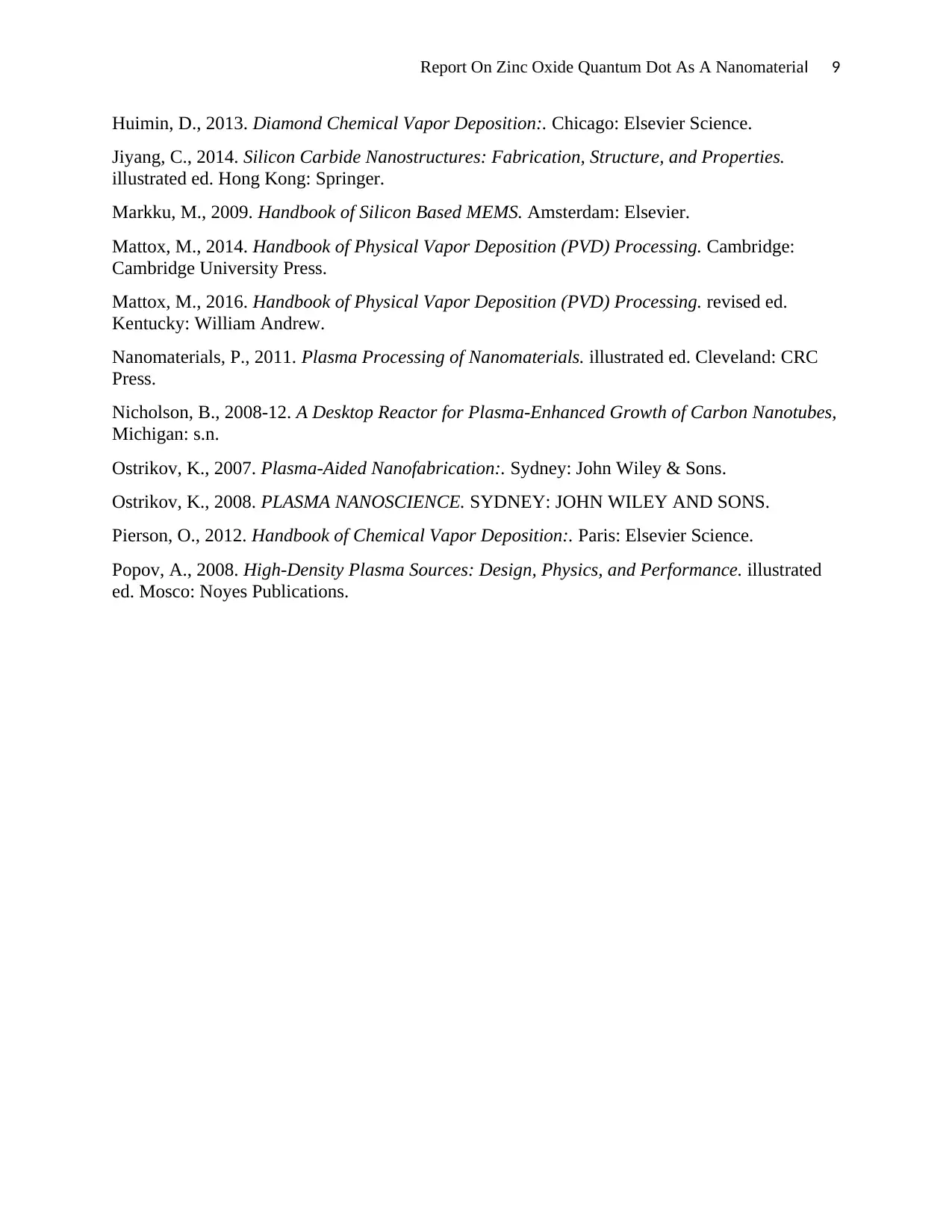
Report On Zinc Oxide Quantum Dot As A Nanomaterial 9
Huimin, D., 2013. Diamond Chemical Vapor Deposition:. Chicago: Elsevier Science.
Jiyang, C., 2014. Silicon Carbide Nanostructures: Fabrication, Structure, and Properties.
illustrated ed. Hong Kong: Springer.
Markku, M., 2009. Handbook of Silicon Based MEMS. Amsterdam: Elsevier.
Mattox, M., 2014. Handbook of Physical Vapor Deposition (PVD) Processing. Cambridge:
Cambridge University Press.
Mattox, M., 2016. Handbook of Physical Vapor Deposition (PVD) Processing. revised ed.
Kentucky: William Andrew.
Nanomaterials, P., 2011. Plasma Processing of Nanomaterials. illustrated ed. Cleveland: CRC
Press.
Nicholson, B., 2008-12. A Desktop Reactor for Plasma-Enhanced Growth of Carbon Nanotubes,
Michigan: s.n.
Ostrikov, K., 2007. Plasma-Aided Nanofabrication:. Sydney: John Wiley & Sons.
Ostrikov, K., 2008. PLASMA NANOSCIENCE. SYDNEY: JOHN WILEY AND SONS.
Pierson, O., 2012. Handbook of Chemical Vapor Deposition:. Paris: Elsevier Science.
Popov, A., 2008. High-Density Plasma Sources: Design, Physics, and Performance. illustrated
ed. Mosco: Noyes Publications.
Huimin, D., 2013. Diamond Chemical Vapor Deposition:. Chicago: Elsevier Science.
Jiyang, C., 2014. Silicon Carbide Nanostructures: Fabrication, Structure, and Properties.
illustrated ed. Hong Kong: Springer.
Markku, M., 2009. Handbook of Silicon Based MEMS. Amsterdam: Elsevier.
Mattox, M., 2014. Handbook of Physical Vapor Deposition (PVD) Processing. Cambridge:
Cambridge University Press.
Mattox, M., 2016. Handbook of Physical Vapor Deposition (PVD) Processing. revised ed.
Kentucky: William Andrew.
Nanomaterials, P., 2011. Plasma Processing of Nanomaterials. illustrated ed. Cleveland: CRC
Press.
Nicholson, B., 2008-12. A Desktop Reactor for Plasma-Enhanced Growth of Carbon Nanotubes,
Michigan: s.n.
Ostrikov, K., 2007. Plasma-Aided Nanofabrication:. Sydney: John Wiley & Sons.
Ostrikov, K., 2008. PLASMA NANOSCIENCE. SYDNEY: JOHN WILEY AND SONS.
Pierson, O., 2012. Handbook of Chemical Vapor Deposition:. Paris: Elsevier Science.
Popov, A., 2008. High-Density Plasma Sources: Design, Physics, and Performance. illustrated
ed. Mosco: Noyes Publications.
1 out of 9
Your All-in-One AI-Powered Toolkit for Academic Success.
+13062052269
info@desklib.com
Available 24*7 on WhatsApp / Email
![[object Object]](/_next/static/media/star-bottom.7253800d.svg)
Unlock your academic potential
© 2024 | Zucol Services PVT LTD | All rights reserved.
